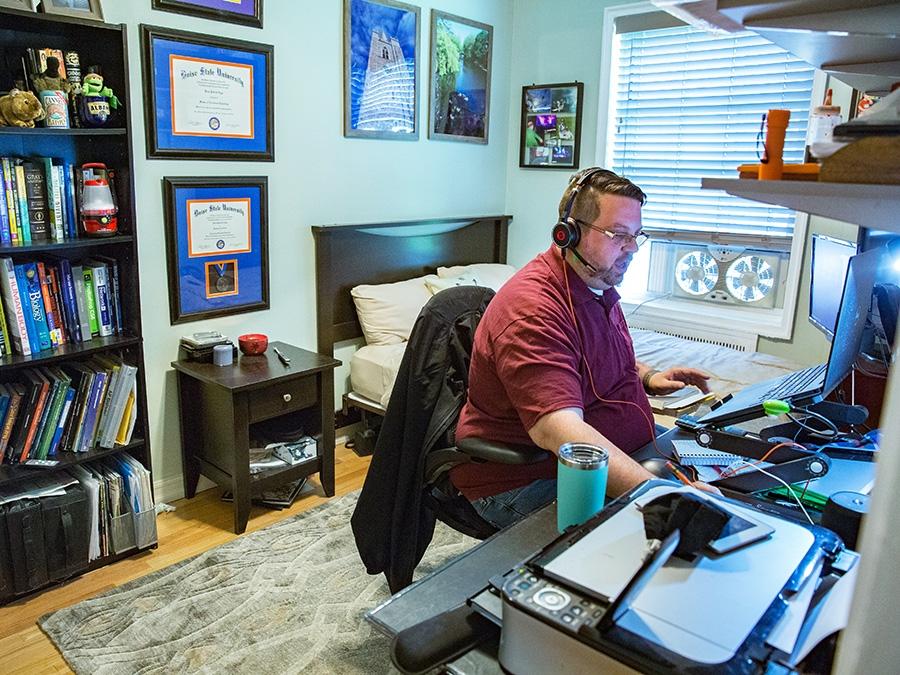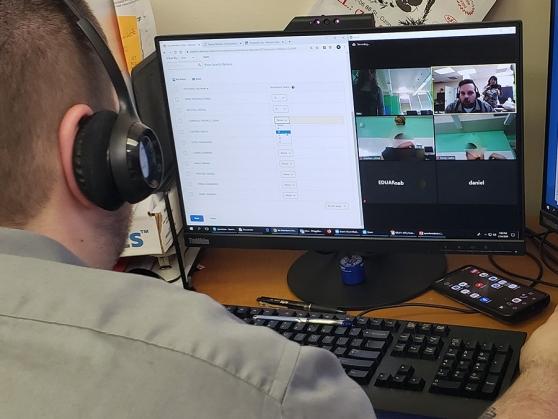Ready for remote

Brian Nagy, part of the inaugural cohort of the city’s remote teaching pilot program, was set up to teach during the pandemic with several computer screens and a document camera in his apartment’s second bedroom.

Before the pandemic, Nagy and his colleagues in the remote teaching pilot program taught from an office in Queens.
When COVID-19 ravaged New York City and forced schools to shut down, Brian Nagy enjoyed a unique position. He was ready for remote.
Nagy, a forensics and computer science teacher, was a member of the inaugural cohort of the city’s small remote teaching pilot program — part of the 2018 DOE-UFT contract — which began offering specialized high school classes remotely in September 2019.
“We had six months under our belts before all hell broke loose,” said Nagy. “We already had our systems in place. It was just a matter of people logging in from a different location.”
Now, as schools fully reopen for in-person instruction this September, Nagy’s assignment in the continuing pilot — remotely teaching students back in schools — will once again become atypical.
The pilot was all about access.
“The goal was to increase access for schools that can’t staff a particular class,” Nagy said. “Maybe there are only three kids who want to take macroeconomics. We can combine with another school and have a remote class.”
Hired for the pilot at the end of the 2018-19 school year, seven teachers spent the summer training to set up classes for the remote teaching pilot. Just before the pandemic, the small cohort, which has since grown to 13, was based in an office in Ozone Park in Queens. “I moved from a 20-minute drive to a 25-second walk to the second bedroom,” Nagy said.
Educators in the program have a regular five-period schedule, just like their in-school colleagues. They remotely teach up to 28 students in each class and the students can be in up to three schools anywhere in the city.
Nagy teaches forensic science and Advanced Placement (AP) computer science principles. The classes offered are health, forensics, and five AP classes: psychology, statistics, macroeconomics, Spanish and computer science. No Regents courses are taught.
Last year, said Nagy, “My first period was in Brooklyn, and so was my third. Fifth period was in the Bronx and my last two classes were in Queens.”
Nagy entered the program with a solid background. He has a master’s in educational technology and years of experience at the Board of Cooperative Educational Services (BOCES) in Nassau County, where he worked with online students before coming to work in city schools in 2013. “I had unknowingly been building my resume,” he said.
Nagy doesn’t mince words when discussing how he aligns the technology with his practice. “I don’t believe in technology for tech’s sake,” he said. “It’s got to be used for a purpose to aid in the learning process.”
Educators can’t recreate a classroom experience virtually, he said. “There’s a different pedagogy that goes with remote.” For example, Nagy said, you create video tutorials of content and assignment instructions, you vary the platforms you use to interact with students, you test out every activity on a cell, an iPad and your computer.
Nagy likes “the challenge of taking hands-on things I used to do face-to-face and trying to figure out the best way to translate that.”
As a science teacher who is used to getting his hands dirty, he is stimulated by the challenge of teaching students who also are not in classrooms. “The best way to get them engaged and active is to get them to be a part of it live, not just looking at it,” he said.
Nagy reconfigured his second bedroom during the pandemic so he could present demonstrations, especially for forensics classes. “I have a little tiny USB document camera,” he explained. “I’m not just showing them a video, pictures. I’m doing things live.”
During a forensics lab on glass evidence, the class had to figure out the order in which impacts happened on glass. “I’m breaking glass intentionally on camera, so the kids can see,” Nagy said.
However, credentials, expertise and technology don’t tell the entire story. Nagy’s mostly positive experience met with feelings of isolation — members in the pilot are a cohort off to themselves and opportunities for collaboration disappeared. “You get lonely and a little stir crazy,” he said. There is no organized union chapter where they can air their concerns or find camaraderie, either. But a return to their Queens office this fall will again give them a place to share their experiences.
What works best for remote teaching? According to Nagy, the ideal remote teaching environment is a school where a rigorous academic program with consistent student expectations is offered, where students have extensive support and where administrators openly communicate with remote teachers.
Thanks to the pilot, Nagy “got to be a little more prepared and a little less apprehensive” when schools closed.
The experience of teaching remotely, he said, is “making me a better teacher. I learned about myself. I reflected. I thought I knew everything; I didn’t.”